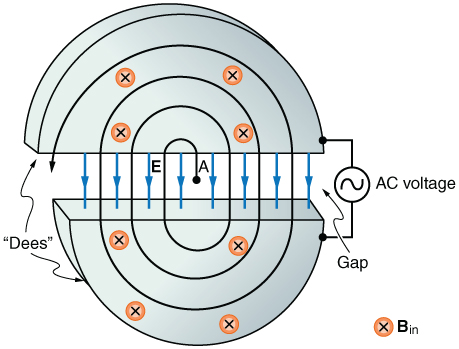| << Chapter < Page | Chapter >> Page > |
Integrated Concepts
A current balance used to define the ampere is designed so that the current through it is constant, as is the distance between wires. Even so, if the wires change length with temperature, the force between them will change. What percent change in force per degree will occur if the wires are copper?
Integrated Concepts
(a) Show that the period of the circular orbit of a charged particle moving perpendicularly to a uniform magnetic field is . (b) What is the frequency ? (c) What is the angular velocity ? Note that these results are independent of the velocity and radius of the orbit and, hence, of the energy of the particle. ( [link] .)

Integrated Concepts
A cyclotron accelerates charged particles as shown in [link] . Using the results of the previous problem, calculate the frequency of the accelerating voltage needed for a proton in a 1.20-T field.
18.3 MHz
Integrated Concepts
(a) A 0.140-kg baseball, pitched at 40.0 m/s horizontally and perpendicular to the Earth’s horizontal field, has a 100-nC charge on it. What distance is it deflected from its path by the magnetic force, after traveling 30.0 m horizontally? (b) Would you suggest this as a secret technique for a pitcher to throw curve balls?
Integrated Concepts
(a) What is the direction of the force on a wire carrying a current due east in a location where the Earth’s field is due north? Both are parallel to the ground. (b) Calculate the force per meter if the wire carries 20.0 A and the field strength is . (c) What diameter copper wire would have its weight supported by this force? (d) Calculate the resistance per meter and the voltage per meter needed.
(a) Straight up
(b)
(c)
(d)2.47 Ω/m, 49.4 V/m
Integrated Concepts
One long straight wire is to be held directly above another by repulsion between their currents. The lower wire carries 100 A and the wire 7.50 cm above it is 10-gauge (2.588 mm diameter) copper wire. (a) What current must flow in the upper wire, neglecting the Earth’s field? (b) What is the smallest current if the Earth’s field is parallel to the ground and is not neglected? (c) Is the supported wire in a stable or unstable equilibrium if displaced vertically? If displaced horizontally?
Unreasonable Results
(a) Find the charge on a baseball, thrown at 35.0 m/s perpendicular to the Earth’s field, that experiences a 1.00-N magnetic force. (b) What is unreasonable about this result? (c) Which assumption or premise is responsible?
(a) 571 C
(b) Impossible to have such a large separated charge on such a small object.
(c) The 1.00-N force is much too great to be realistic in the Earth’s field.

Notification Switch
Would you like to follow the 'Introductory physics - for kpu phys 1100 (2015 edition)' conversation and receive update notifications?